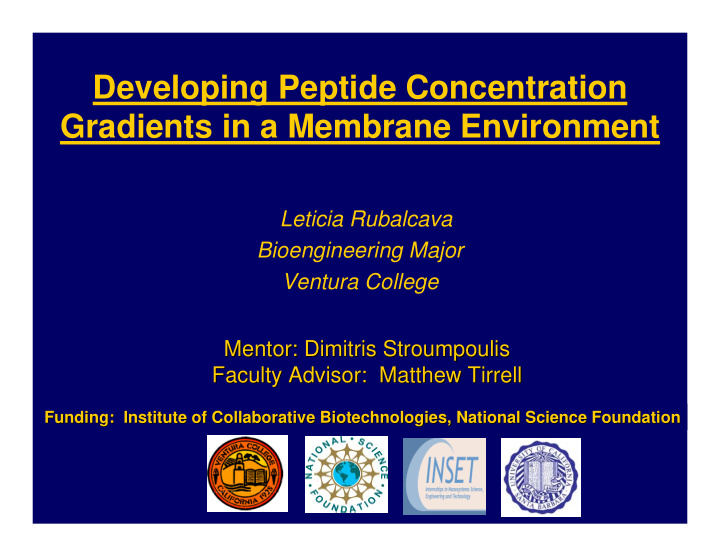



Developing Peptide Concentration Gradients in a Membrane Environment Leticia Rubalcava Bioengineering Major Ventura College Mentor: Dimitris Stroumpoulis Mentor: Dimitris Stroumpoulis Faculty Advisor: Matthew Tirrell Faculty Advisor: Matthew Tirrell Funding: Institute of Collaborative Biotechnologies, National Science Foundation cience Foundation Funding: Institute of Collaborative Biotechnologies, National S
Structure • Introduction- Importance of cell binding to the ECM • Motivation • Purpose of Concentration Gradients • Objectives • Approach • Microfluidic Devices and Microscopy Images • Results • Future Research
Introduction • Cells in Cells in multicellular multicellular • organisms are anchored to organisms are anchored to Arg-Gly-Asp extracellular matrix extracellular matrix RGD Intengrins and the RGD and the RGD • Intengrins • binding site binding site • Design of Design of biomimetic biomimetic • materials depends on materials depends on understanding cell behavior on understanding cell behavior on functionalized surfaces functionalized surfaces “Integrins and Health.” Horwitz Alan F. Scientific American May 1997 http://www.med.unc.edu/~meissner/sciamer.pdf
What is a Concentration What is a Concentration Gradient? Gradient? • Change in concentration of a • Change in concentration of a solute across a distance solute across a distance • Many different concentrations on a single surface Why Research Peptide Why Research Peptide Solution less Solution more concentrated Concentrated Concentration Gradients? Concentration Gradients? • Contribute knowledge for the development of surface properties that promote favorable Cell Cell reactions by cells • Future contribution to bio- engineered materials Diffusion Barriers Diffusion Barriers Picture courtesy by Dimitris Stroumpoulis
Objectives • Create surface concentration • Create surface concentration gradients using vesicle gradients using vesicle solutions solutions Lipid Bilayer- different peptide concentrations • • Formation of a lipid bilayer Formation of a lipid bilayer Peptides by vesicle fusion by vesicle fusion (extracellular matrix- (extracellular matrix - like) like) • Use of vesicles containing • Use of vesicles containing RGD peptides RGD peptides Barrier Hydrophobic Hydrophilic Substrate Hydrophilic Picture Courtesy by Dimitris Stroumpoulis
Experimental Methods • Poly(dimethylsiloxane) (PDMS) mold from wafer -Create inlets and outlet -Glass slide treated with plasma hydrophilic Wafer • Flow of vesicle solutions -Egg (PC) (lipids) & Texas Red (lipids and fluorescent dye) -No peptides Syringe Hoses • Observation of • gradient using microscope and fluorescent light Glass PDMS
Microfluidic Devices Method 1: Reversible sealing Not Plasma treated + Bubbles Plasma Treated Form Glass Glass Irreversible sealing Method 2: Plasma Treated Plasma Treated + Glass No bubbles Glass form Reversible sealing & Method 3: Bonded and No bubbles form Plasma Treated Glass Glass
Microscopy Images •Gradients viewed under fluorescent light Poor Gradient Method 3 100 µm Method 1 Good Gradient 200 µm Bubble 3 mm
Results Intensity vs Position Intensity vs. Position Sol. 6 Sol. 4 Sol. 5 12000 Sol. 3 10000 Intensity 8000 Sol. 2 ity s n 6000 te In 4000 Sol. 1 2000 0 6 : Solution: 1 2 3 4 5 0 0.5 1 1.5 2 2.5 3 Position (mm) Position (mm) • From glass slide to glass containing grid Glass Glass Grid No grid
Summary and Future Research Summary Summary Achieved Achieved Creation of Reversible sealing & gradient in no bubbles solution In the Process Creation of gradient on Use of new microfluidic glass containing barrier channel design Use of vesicles Observation of containing bilayer under Peptides Microscope Future Research •Research cell behavior (e.g. cell migration & cell spreading) on peptide surface bound concentration gradient surfaces
Acknowledgements I would like to thank… � My Mentor Dimitris Stroumpoulis � Matthew Tirrell- Faculty Advisor � INSET Program
Solution Concentrations Egg PC Texas Red Buffer Total Solution 1 1.5 ml 0 ml 1.5 ml 3 ml Solution 2 1.2 ml 0.3 ml 1.5 ml 3 ml Solution 3 0.9 ml 0.6 ml 1.5 ml 3 ml Solution 4 0.6 ml 0.9 ml 1.5 ml 3 ml Solution 5 0.3 ml 1.2 ml 1.5 ml 3 ml Solution 6 0 ml 1.5 ml 1.5 ml 3 ml
Vesicle Fusion Picture Courtesy by Dimitris Stroumpoulis
Lipids Used • Egg phosphatidylcholine (PC) •http://en.wikipedia.org/wiki/Phosphatidylch oline
Recommend
More recommend